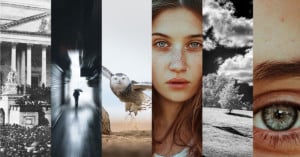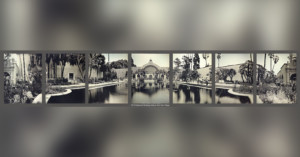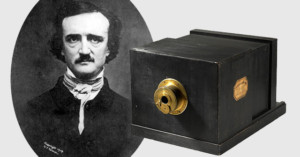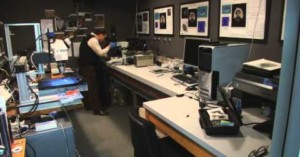
The Very First Pets Ever To Be Photographed
For nearly as long as there have been cameras, there have been photos of pets, some of which date back to the early 1800s.

For nearly as long as there have been cameras, there have been photos of pets, some of which date back to the early 1800s.

Posing with her daughter who leans on her shoulder, a Victorian mother stares mournfully into the camera. But her cheerless expression is understandable when you realize that her peaceful daughter beside her is dead.

I write about a lot of things here at PetaPixel -- reviews, guides, technical articles, opinion pieces -- but one of my favorite topics to write about is the history of photography. As an avid user and collector of vintage cameras and lenses, I have passionately absorbed as much knowledge about their history as possible over many years. Like studying world history, there is much value in understanding where we came from and what got to us where we are now.

A photograph of Joseph Smith, the founder of Mormonism and the Latter Day Saint movement, has been discovered in a locket belonging to his great-great-grandson. It is the only known photo that exists of the American prophet.

A court has ruled that Harvard University can be sued over a series of photographs that depict enslaved people by a woman who is a descendent of the subjects.

Cased daguerreotypes are among the oldest photographic images in Australian gallery, library, and museum collections.

This photo is of a woman known as "Aunty Moser," who was possibly 102 years old when she sat for a daguerreotype portrait in 1852, making her one of the earliest-born people to be photographed.

Some of the earliest photographic portraits taken in America were recently discovered in an unheated shed on Long Island. The historically significant find contains photographs from some of the first experiments with the daguerreotype process.

We all love interesting and perhaps somewhat obscure facts and anyone reading this site has at least a moderate interest in cameras -- and hopefully, their history. Part of that history includes the unique, weird, one-of-a-kind, and (you guessed it) extremely expensive cameras which have, in one way or another, played a role in paving the way to where we are today.

A collection of early American photography from Larry J. West has been acquired by the Smithsonian American Art Museum, transforming the museum’s holdings. West’s collection includes 286 pieces from the 1840s, when daguerreotypes started to show up in the US, to about 1925.

A Massachusetts judge has dismissed a woman's lawsuit claiming that she is the rightful owner of the images of an enslaved father and daughter and not Harvard, the New York Times reports. The judge cites common law that the content of an image cannot be used to claim ownership of that image, regardless of the subject.

In early spring 1839, Paris was abuzz with excitement in connection with a recently published letter, in which the invention of photography was confirmed by reliable sources. The world was now waiting for the French government to work out a deal with its inventor Louis J.M. Daguerre for details of the daguerreotype process to become public.

Having now finalized work on this series, I will attempt to put into words its impetus, as well as how it came to fruition. This will be a lengthy entry, proportional in size to the monumentally significant nature of this work for me, and therefore I shall start from the beginning, as all things have their origins.

Every Sunday, we bring together a collection of easy reading articles from analytical to how-to to photo-features in no particular order that did not make our regular daily coverage. Enjoy!

This trip has been waiting in the wings ever since I made my first successful daguerreotype in the redwoods two years ago. I actually planned on going as early as August this year, but one project after another kept getting in the way, and for months I kept pushing it back by a couple of weeks.

Toward the end of November, I went back to one of my favorite places in the desert. A spot out in the middle of nowhere, with the nearest significant human population well over an hour drive away.

Every Sunday, we bring together a collection of easy reading articles from analytical to how-to to photo-features in no particular order that did not make our regular daily coverage. Enjoy!

In a behind the scenes video worthy of r/oddlysatisfying, the Museum of Modern Art (MoMA) joins expert conservator Lee Ann Daffner to show you what it takes to clean, rehouse, and ultimately save one of the oldest photographs on Earth from being eaten away by its own chemistry.

Chimacabres come out at night. They are around during the day too of course, but the night is when they really thrive. In the dark, it’s harder to tell if you’re face to face with a fellow person or if it’s a chimacabre in front of you, and they don’t even have faces.

There are plenty of well-known firsts in the history of photography, but the question of what the oldest animal photo is has thus far been an unsettled one. But a newly-surfaced photo of cows may possibly be the oldest animal photograph discovered thus far.

I always resisted writing artist statements and bios. In school, that part of every assignment or exhibition was the most agonizing. It felt overly simplistic to just describe what the viewer was about to encounter, or why objects or abstract shapes, making my specific image or groups of images, were presented in this way or another.

I’ve been experimenting non-stop with a few new daguerreotype techniques lately, and however promising the results are looking so far, those experiments are slow going. But here’s something I thought up and was able to execute in a relatively speedy manner -- something I believe warrants a look. I don’t believe this method of making a panoramic image has ever been utilized before, so I’m dubbing it the "Antorama."

Harvard University is being sued over daguerreotypes of slaves -- believed to be the earliest photos of American slaves -- commissioned by one of its professors back in 1850. A descendant of the slaves accuses Harvard of wrongfully seizing, possessing, and profiting from the photos.

There's a new photo recovery technique that may help humanity recover some of the world's oldest photographs that were previously considered to be damaged beyond repair.

Given that most photos are captured digitally and shared online, it’s easy to forget the beauty of a print.

Those who have known me long enough are aware of my passion for Rolleiflex cameras. Back before I got deeper and deeper into alternative photography I used to shoot my TLRs all the time.

If film is "dead," then the daguerreotype is a distant memory. But thanks to photographers like Binh Danh, this magical photographic process is still alive, well, and capturing some of the same epic landscapes it was being used to capture a century ago.

Poet Edgar Allan Poe had glowing things to say about photography after it exploded onto the scene in the mid-1800s. Other commentators in those days weren't so kind.
There are quite a few cartoons from the 1800s that show a more pessimistic view of photography and its emergence in the world.

Did you know that when the daguerreotype was announced back in 1839, one of the people who wrote about the new groundbreaking technology was the famous poet Edgar Allan Poe?
After the world's first publicly announced photographic process was unveiled in January 1839, Poe wrote an article for the Philadelphia paper Alexander's Weekly Messenger in January 1840 titled, "The Daguerreotype." In the piece, Poe called the invention "perhaps the most extraordinary triumph of modern science."

At the ripe old age of 103, New Englander Conrad Heyer, a veteran of the American Revolution, sat down to have his portrait taken. Maybe he knew this at the time, or maybe he didn't, but the gruff, stern man staring defiantly out of the portrait above is believed to be the earliest born human ever photographed.

News flash: You can't believe everything you see on Twitter. We know, we were shocked too.
Such was the case with this striking sepia-toned image that started lighting up the mediasphere yesterday billed as "the Earliest Photograph Taken of New York City - Broadway, May 1850." (And immediately started attracting comments in the vein of: "And they haven't fixed the potholes since!")

Selfie, schmelfie! How self-absorbed do you really have to be to spend all of 20 seconds pointing a phone at yourself and tapping a few buttons? But a process that requires up to 15 minutes of statue-still posing, exposure to hazardous chemicals and construction of custom camera? Now that's something worth bragging about.
So all hail pioneering American photographer Robert Cornelius, whose rough but certainly recognizable image, taken mere months after Louis Daugerre revealed his daguerrotype process in 1839, is undoubtedly the world's first photographic self-portrait and may even be the first photographic portrait of any kind.

The way film photographers feel about digital photographers may be the way daguerreotype photographers feel about the film guys. Working with dangerous chemicals, buffing out silver coated plates, spending an entire day preparing for, taking and developing one shot; that's what daguerreotype photographers love to do. It's the difference between "crafting a photograph" and "just snapping away."
In this short film -- put together by photographer and videographer Patrick Richardson Wright -- Seattle-based photog Dan Carrillo talks about that craftsmanship, as well as the beauty and permanence of daguerreotype photography that keeps him doing it when others say "why bother."

If you've never heard a basic overview of the history of photography, then this cute little animated video from TED-Ed is here for you. It covers everything from the invention of the camera obscura, to the battle between the calotype and the daguerreotype, to the rise of portable cameras.

Eight years ago, it was discovered that some of the earliest daguerreotypes ever taken were fading away before our very eyes. Given the historical significance of these photographs, watching them deteriorate over time was unacceptable. So, in an attempt to save them, George Eastman House has enlisted the help of the University of Rochester.

The Library of Congress has an extensive collection of daguerreotype photographs captured over the past two centuries. In addition to browsing the technically perfect ones that document history and people, it's also interesting to look at metal plates that are flawed.

Just in case this question ever comes up while you’re playing the world’s hardest game of photography trivia, what …

In daguerreotype photography, the first commercially successful photographic process, a positive image is recorded directly onto a silvered copper plate. Although mercury is traditionally used to develop the plate, there's a way of creating daguerreotypes called the Becquerel method that eschews mercury in favor of non-lethal ingredients.

George Eastman House released this video recently that provides a quick lesson on …

The 120° panoramic image (and its crop) you see above is titled "Daguerreotype View of Cincinnati" and was captured in 1848 by Porter and Fontayne from Newport, Kentucky. It was created with eight full-plate daguerreotypes and shows a two mile stretch of the Cincinnati waterfront.